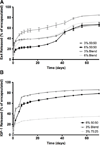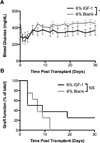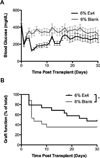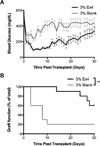Enhancing human islet transplantation by localized release of trophic factors from PLG scaffolds
- PMID: 24909237
- PMCID: PMC4232190
- DOI: 10.1111/ajt.12742
Enhancing human islet transplantation by localized release of trophic factors from PLG scaffolds
Abstract
Islet transplantation represents a potential cure for type 1 diabetes, yet the clinical approach of intrahepatic delivery is limited by the microenvironment. Microporous scaffolds enable extrahepatic transplantation, and the microenvironment can be designed to enhance islet engraftment and function. We investigated localized trophic factor delivery in a xenogeneic human islet to mouse model of islet transplantation. Double emulsion microspheres containing exendin-4 (Ex4) or insulin-like growth factor-1 (IGF-1) were incorporated into a layered scaffold design consisting of porous outer layers for islet transplantation and a center layer for sustained factor release. Protein encapsulation and release were dependent on both the polymer concentration and the identity of the protein. Proteins retained bioactivity upon release from scaffolds in vitro. A minimal human islet mass transplanted on Ex4-releasing scaffolds demonstrated significant improvement and prolongation of graft function relative to blank scaffolds carrying no protein, and the release profile significantly impacted the duration over which the graft functioned. Ex4-releasing scaffolds enabled better glycemic control in animals subjected to an intraperitoneal glucose tolerance test. Scaffolds releasing IGF-1 lowered blood glucose levels, yet the reduction was insufficient to achieve euglycemia. Ex4-delivering scaffolds provide an extrahepatic transplantation site for modulating the islet microenvironment to enhance islet function posttransplant.
Keywords: Bioengineering; islet xenotransplantation; regenerative medicine; type 1 diabetes mellitus.
© Copyright 2014 The American Society of Transplantation and the American Society of Transplant Surgeons.
Conflict of interest statement
The authors of this manuscript have conflicts of interest to disclose as described by the
Figures








Similar articles
-
Porous scaffolds support extrahepatic human islet transplantation, engraftment, and function in mice.Cell Transplant. 2013;22(5):811-9. doi: 10.3727/096368912X636966. Cell Transplant. 2013. PMID: 22507300 Free PMC article.
-
Polymer scaffolds as synthetic microenvironments for extrahepatic islet transplantation.Transplantation. 2006 Aug 27;82(4):452-9. doi: 10.1097/01.tp.0000231708.19937.21. Transplantation. 2006. PMID: 16926587 Free PMC article.
-
Exendin-4 does not promote Beta-cell proliferation or survival during the early post-islet transplant period in mice.Transplant Proc. 2008 Jun;40(5):1650-7. doi: 10.1016/j.transproceed.2008.03.161. Transplant Proc. 2008. PMID: 18589167 Free PMC article.
-
Extracellular matrix protein-coated scaffolds promote the reversal of diabetes after extrahepatic islet transplantation.Transplantation. 2008 May 27;85(10):1456-64. doi: 10.1097/TP.0b013e31816fc0ea. Transplantation. 2008. PMID: 18497687 Free PMC article.
-
Advancing islet transplantation: from engraftment to the immune response.Diabetologia. 2011 Oct;54(10):2494-505. doi: 10.1007/s00125-011-2243-0. Epub 2011 Aug 10. Diabetologia. 2011. PMID: 21830149 Free PMC article. Review.
Cited by
-
Islet implantation in a pocket.Nat Biotechnol. 2015 May;33(5):493-4. doi: 10.1038/nbt.3216. Nat Biotechnol. 2015. PMID: 25965759 No abstract available.
-
Restoring normal islet mass and function in type 1 diabetes through regenerative medicine and tissue engineering.Lancet Diabetes Endocrinol. 2021 Oct;9(10):708-724. doi: 10.1016/S2213-8587(21)00170-4. Epub 2021 Sep 1. Lancet Diabetes Endocrinol. 2021. PMID: 34480875 Free PMC article. Review.
-
A Collagen Based Cryogel Bioscaffold that Generates Oxygen for Islet Transplantation.Adv Funct Mater. 2020 Apr 14;30(15):1902463. doi: 10.1002/adfm.201902463. Epub 2020 Feb 20. Adv Funct Mater. 2020. PMID: 33071709 Free PMC article.
-
A bioengineered niche promotes in vivo engraftment and maturation of pluripotent stem cell derived human lung organoids.Elife. 2016 Sep 28;5:e19732. doi: 10.7554/eLife.19732. Elife. 2016. PMID: 27677847 Free PMC article.
-
Modulation of adipocyte size and fat pad weight via resveratrol releasing scaffolds implanted into the epididymal adipose tissue.J Biomed Mater Res A. 2021 May;109(5):766-778. doi: 10.1002/jbm.a.37063. Epub 2020 Aug 11. J Biomed Mater Res A. 2021. PMID: 32681806 Free PMC article.
References
-
- Shapiro AM, Lakey JR, Ryan EA, et al. Islet transplantation in seven patients with type 1 diabetes mellitus using a glucocorticoid-free immunosuppressive regimen. N Engl J Med. 2000;343:230–238. - PubMed
-
- Shapiro AM, Ricordi C, Hering BJ, et al. International trial of the Edmonton protocol for islet transplantation. N Engl J Med. 2006;355:1318–1330. - PubMed
-
- Pambianco G, Costacou T, Ellis D, Becker DJ, Klein R, Orchard TJ. The 30-year natural history of type 1 diabetes complications: The Pittsburgh Epidemiology of Diabetes Complications Study experience. Diabetes. 2006;55:1463–1469. - PubMed
-
- Barshes NR, Wyllie S, Goss JA. Inflammation-mediated dysfunction and apoptosis in pancreatic islet transplantation: Implications for intrahepatic grafts. J Leukoc Biol. 2005;77:587–597. - PubMed
Publication types
MeSH terms
Substances
Grants and funding
LinkOut - more resources
Full Text Sources
Other Literature Sources
Medical
Miscellaneous

